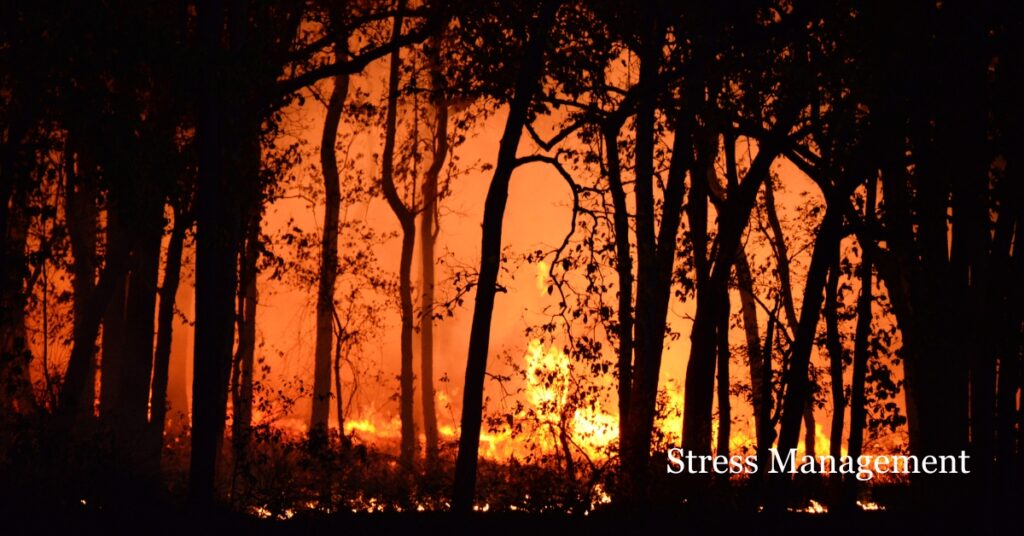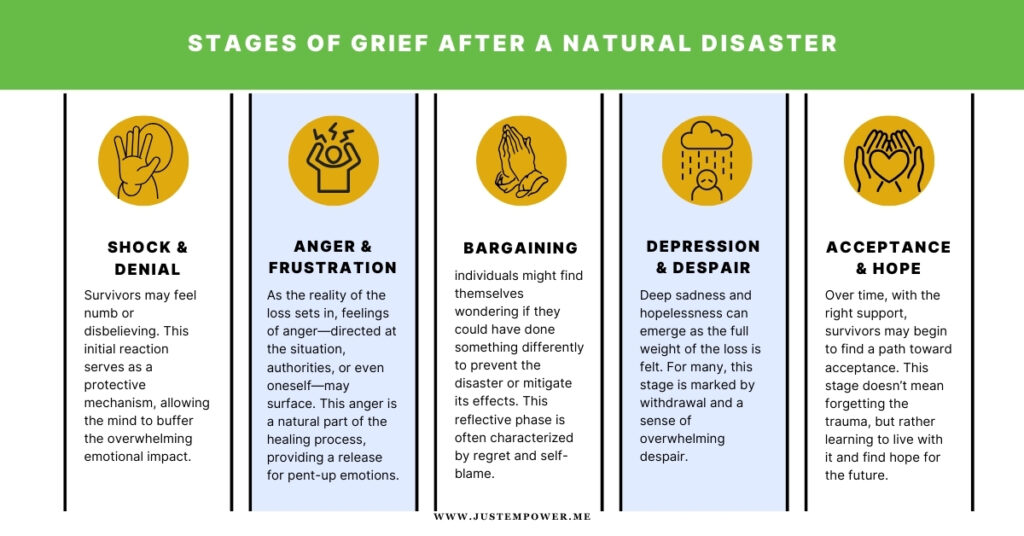
The recent wildfires in Los Angeles have left many feeling shaken and overwhelmed—not just by the loss of property, but by the emotional and psychological impact of such a crisis.
As therapists, we have witnessed firsthand how natural disasters can trigger deep-seated trauma and disrupt our sense of safety and well-being.
In this post, we’ll explore natural disaster trauma, the stages of grief after a natural disaster, and effective strategies for coping with traumatic events. We’ll also discuss how to foster emotional recovery after natural disasters and support mental health during these challenging times.
Understanding Natural Disaster Trauma
Natural disasters, such as the wildfires that recently affected Los Angeles, are not only physical events—they’re emotional experiences that can leave lasting scars. Natural disaster trauma refers to the psychological impact that results from experiencing or witnessing a catastrophic event. This trauma can manifest in various ways, ranging from heightened anxiety and sleep disturbances to more severe symptoms like post-traumatic stress disorder (PTSD) [1].
Many people ask, “Can you get trauma from natural disasters?” The answer is yes. When disaster strikes, the sudden loss of control, the disruption of daily life, and the fear for personal safety can overwhelm even the most resilient individuals.
Even if you were not directly impacted by a natural disaster, seeing the images on the news and hearing stories from acquaintances can lead to long-term mental health challenges if not addressed appropriately.
What Are the Stages of Grief After a Natural Disaster?
Grief is a natural response to loss, and it often follows a distinct process after a natural disaster or during times of crisis such as the Israeli-Palestinian Conflict. Although every individual’s experience is unique, many people go through similar stages of grief, including:
-
Shock and Denial
Immediately after a disaster, survivors may feel numb or disbelieving. This initial reaction serves as a protective mechanism, allowing the mind to buffer the overwhelming emotional impact.
-
Anger and Frustration
As the reality of the loss sets in, feelings of anger—directed at the situation, authorities, or even oneself—may surface. This anger is a natural part of the healing process, providing a release for pent-up emotions.
-
Bargaining
In this stage, individuals might find themselves wondering if they could have done something differently to prevent the disaster or mitigate its effects. This reflective phase is often characterized by regret and self-blame.
-
Depression and Despair
Deep sadness and hopelessness can emerge as the full weight of the loss is felt. For many, this stage is marked by withdrawal and a sense of overwhelming despair.
-
Acceptance and Hope
Over time, with the right support, survivors may begin to find a path toward acceptance. This stage doesn’t mean forgetting the trauma, but rather learning to live with it and find hope for the future.
Understanding these stages of grief after a natural disaster is crucial. It not only normalizes your emotional experience but also provides a roadmap for recognizing when professional support might be beneficial.

PTSD from Natural Disasters
For some survivors, the emotional impact of a disaster can be so severe that it leads to PTSD from natural disasters. PTSD, or post-traumatic stress disorder, is characterized by persistent, intrusive memories of the traumatic event, flashbacks, nightmares, and severe anxiety. These symptoms can interfere significantly with daily life, making it difficult to work, maintain relationships, or even perform routine tasks.
If you or someone you love is experiencing symptoms of PTSD after a disaster, it’s important to seek help. Professional therapy, including trauma-focused therapies like Cognitive Behavioral Therapy (CBT) or Exposure Therapy, can be highly effective in managing these symptoms and aiding recovery.
Coping with a Traumatic Event: Strategies for Recovery
Coping with a traumatic event, especially one as disruptive as a natural disaster, can feel daunting. However, there are several strategies you can employ to start the healing process:
1. Practice Grounding Techniques
Grounding techniques are a powerful tool for managing overwhelming emotions in the immediate aftermath of trauma. Simple practices, such as deep breathing exercises or the “physiological sigh” (a double inhale followed by a slow exhale), can help calm your nervous system and bring you back to the present moment. These methods are particularly useful when you feel overwhelmed by memories or flashbacks.
2. Create a Safe and Calming Environment
After a disaster, your surroundings may feel chaotic or triggering. Take time to create a space that feels safe and peaceful. This might include:
- Setting up a quiet corner with soft lighting and comforting objects.
- Playing soothing music or sounds that help you relax.
- Reducing clutter and creating a visually calming environment.
A supportive and calming space can serve as your personal retreat when feelings of anxiety or trauma become overwhelming.
3. Connect with Others
Social support is one of the most effective antidotes to trauma. Whether it’s talking with friends, joining a support group, or seeking professional counseling, connecting with others can help you process your feelings and reduce isolation. Remember, you don’t have to cope with the aftermath of a natural disaster on your own.
4. Seek Professional Help
If you’re struggling to cope, consider reaching out for professional help. Therapists trained in trauma counseling can guide you through the recovery process, offering personalized strategies and support to manage symptoms and foster resilience. Professional intervention is particularly crucial if you’re experiencing prolonged distress or signs of PTSD.
5. Engage in Self-Care and Mindfulness
Self-care is vital during times of crisis. Incorporate activities that nurture your body and mind—be it regular exercise, healthy eating, meditation, or simply taking time to rest. Mindfulness practices and sensory regulation, in particular, can help you stay grounded and reduce the intensity of traumatic memories.
Emotional Recovery After Natural Disaster Trauma and Times of Crisis
Emotional recovery after natural disasters is a gradual process. It involves not only healing from the immediate trauma but also learning to adapt and rebuild your life. Here are some key aspects of emotional recovery:
-
Allow Yourself to Grieve
Accept that it’s okay to feel a range of emotions—from anger and sadness to confusion and numbness. Grieving is a natural part of the healing process.
-
Set Realistic Goals
Focus on small, achievable steps that help rebuild your sense of normalcy. This might include re-establishing daily routines, reconnecting with loved ones, or finding new sources of comfort and joy.
-
Celebrate Small Victories
Recognize and celebrate the progress you make, no matter how minor it may seem. Each step forward is a testament to your resilience.
-
Embrace Community Support
Engage with community initiatives or local support groups that focus on recovery. Shared experiences can provide strength and a sense of belonging during a challenging time.
How to Cope After a Natural Disaster
Coping after a natural disaster involves a combination of immediate actions and long-term strategies. Here are some practical tips to help you navigate the aftermath:
-
Establish a Routine
Even a simple daily routine can provide structure and stability. Regular sleep, meals, and activities can help ground you during chaotic times.
-
Limit Media Exposure
While it’s important to stay informed, constant exposure to distressing news can amplify anxiety. Set boundaries on how much time you spend consuming disaster-related media.
-
Practice Self-Compassion
Be gentle with yourself. Understand that healing is not linear, and it’s normal to have good days and bad days.
-
Engage in Relaxation Practices
Whether it’s yoga, meditation, or simply taking a walk in nature, find activities that help you relax and recharge.
-
Stay Connected
Reach out to friends, family, or community groups. Sharing your experience and listening to others can ease feelings of isolation and foster collective healing.
Moving Forward: Mental Health After a Natural Disaster
In the wake of a natural disaster, the journey toward recovery is both personal and collective. While the trauma caused by natural disasters can leave deep emotional scars, there is hope. With the right support and strategies, survivors can achieve emotional recovery and build resilience.
If you or someone you know is struggling with natural disaster trauma, please remember that help is available.
Professional therapy, support groups, and self-care practices can guide you through this challenging time. Reaching out to a mental health professional can provide you with the tools needed to navigate the aftermath, cope with the loss, and ultimately rebuild your life.
The Impact of Natural Disaster Trauma and How to Move Forward
The recent fires in LA remind us of the fragile nature of life and the profound impact that natural disasters can have on our mental health. Whether you’re experiencing PTSD from natural disasters, wondering “what are the stages of grief after a natural disaster?”, or simply searching for ways on how to cope after a natural disaster, know that you are not alone.
As therapists, we’re here to help you understand and process your feelings, develop effective coping strategies, and support your journey toward emotional recovery.
If you’re struggling with the mental health aftermath of a natural disaster, consider reaching out for professional help. Early intervention is key to preventing long-term psychological distress and building a resilient future. Together, we can work on strategies for coping with a traumatic event, understanding your sensory triggers, and taking concrete steps toward healing.
If you’re ready to take the next step in your healing journey or need someone to talk to about mental health after a natural disaster, contact our office today for support and guidance.
